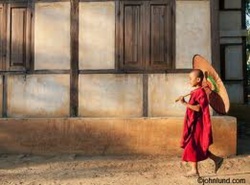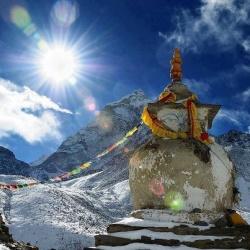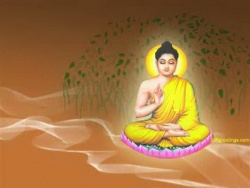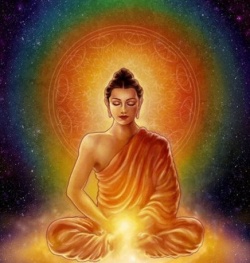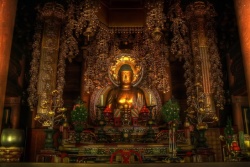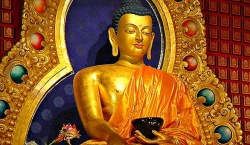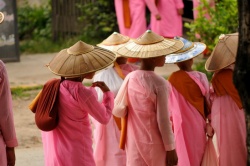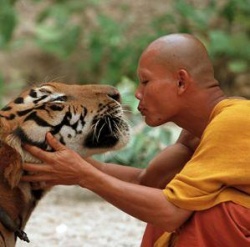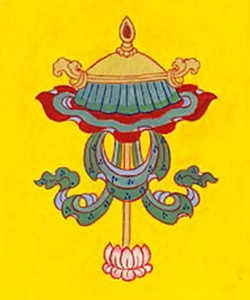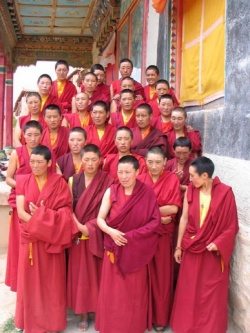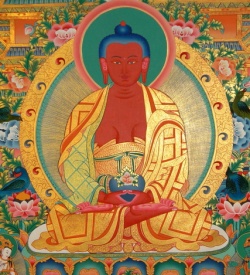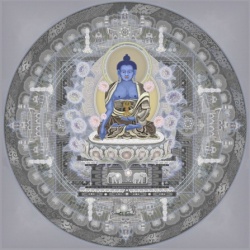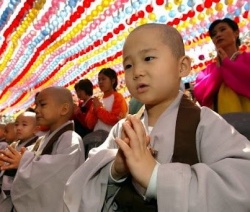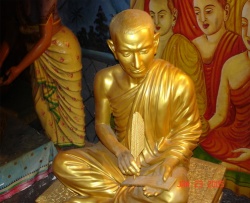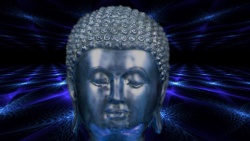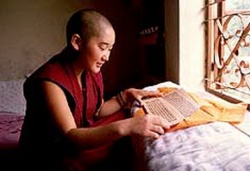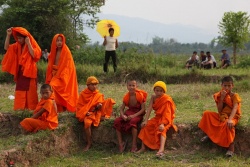Difference between revisions of "Vajrayana Buddhism Vis-à-vis Hindu Tantricism"
| Line 1: | Line 1: | ||
| − | {{DisplayImages|2314|2674|930|42|1854|1172|2854|2510|3525|2918|3236|776|1872|2128|1277|2009|2360|2936|2286|3157 | + | {{DisplayImages|2314|2674|930|42|1854|1172|2854|2510|3525|2918|3236|776|1872|2128|1277|2009|2360|2936|2286|3157}} |
<poem> [[Acharya]] Mahayogi Sridhar Rana [[Rinpoche]] | <poem> [[Acharya]] Mahayogi Sridhar Rana [[Rinpoche]] | ||
Revision as of 22:32, 22 February 2014
Acharya Mahayogi Sridhar Rana Rinpoche
As both Hindu Tantra and Buddhist Tantra (also known as Vajrayana) are profound subjects and I am neither a Siddha nor a Pandit, I have great trepidation in writing about these topics. However, many writers have stated that both Tantras are basically the same, when in fact they are very different. Hindu Tantra is based on the Hindu Advaita which means view of one form or the other of Monism. Vajrayana is based on Advaya or non-dual. This Buddhist tenet comes from the expositions of Nagarjuna and his followers (known as Madhyamika), and the Asanga/Vasubahndu (Chittamatra) group. Hence, to extricate Vajrayana from the wrong views surrounding its meaning, I feel compelled to write.
The main point is not whether Hindu Tantra has influenced Buddhist Tantra or vice-versa. The cited influences have always depended on which school the writers belonged to. If the writer was a non-Tantric Hindu and felt uneasy with Hindu Tantra, he has written about Tantra entering Hinduism through Buddhism. If he was a Hindu Tantric, he expressed that Vedas contain Hindu Tantra and the Buddhists copied them. If he was a non-Tantric Buddhist, he has written that later day Buddhists copied Tantra from Hinduism. However, these are all hypotheses. No solid historical proof exists to verify these claims.
Coming back to our main topic, since all spiritual systems can be divided into Ground, Path, and Fruit (Bhumi, Marga, Phala), we shall attempt to show how Hindu Tantra and Buddhist Vajrayana are totally different from each other in these aspects.
But first, let us examine the meaning of word Tantra. The definition itself is different in the two systems.
The Hindu Tantra (as stated by Sir John Woodroffe and Dhana Shumsher) is etymologically split up into tananat and trayate iti tantra. Tananat means to expand or expansion. Trayate means to liberate or become free. Putting them together, the meaning comes out as to become free or liberate by expansion.
Expansion of what? It is the expansion of the limited consciousness into the infinite Brahman, Chit, Chidshana, Chit Shakti, Mahamaya, Parasamvit, Paramshiva, Parabindu and so on. In a very simplified form, a Jiva (being) is limited by the various constrictions (Kancukas) and the eight bonds (called Asta pasa). When the consciousness of the Jiva breaks through these Kancukas and Pasas by expansion, he becomes Shiva.
Pasa Yukta Bhavet Jiva
Pasa Mukta Sadashiva
He who is bound by Pasa (bond) is Jiva. He who is free of the Pasas is Sadashiva. So this is the definition of Tantra within the Hindu network.
In Vajrayana Buddhism, the practice and teachings are not limited to Tantra alone. Vajrayana is also known as Upayayana, Guhyayana, and Mantrayana. Upayayana signifies a way of skillful means. Vajrayana has infinite methods to suit each individual's temperaments, situations, conditions, and predilections in the attainment of Buddhist Enlightenment. It includes non-Tantric (technically called Sutra) and Tantric techniques also. So Vajrayana is not limited to the use of mantras and deities only, as is sometimes implied. Methods and techniques of Sutra meditation are also found in Vajrayana, as well as Vipassyana meditations of all four types of mindfulness as practiced in Pali Buddhism. But we also find Tantric Vipassyana within Vajrayana, which uses mantra and deity visualization for Samatha and Vipassyana practices.
Let us now examine the definition of Tantra as used in Buddhist Vajrayana context. Buddhism uses the etymological meanings of the word Tantra, which is continuum or continuity. Sanskrit word for Tantra, i.e. continuum, is Santaan. The Tibetan word for Tantra is rgyud, which also means continuum. The Guhyasamaja Tantra defines Tantra as: a continuity and this is threefold: Ground, Path and Fruit.
The Guhyasamaja Tantra also calls Tantra - Prabandha. Though both Hindus and Buddhists use the word Prabandha, here too the meaning is different.
For Hindu Tantra, Prabandha means systematization.
In Buddhist Tantra, Prabandha means continuity and integration. Rong Zom Chokyi (11th century Tibetan and a contemporary of Marpa), who was a Sanskritist, preferred integration. He meant it in the sense of integrating into one whole (or holistic) the different aspects and processes of personality. However, continuum has become the more popular term.
Within Buddhism, Tantra is so multi-faceted that a single word or meaning like integration or continuum cannot fully explain its true significance. It requires multiple definitions.
Long Chen Rabjyam-pa (1308-1363), a great Nyingma Tibetan Master, in his Thegpai Chog Rinpoche Zo (Uttama Yana Ratna Kosha) has written a series of definitions of Tantra. In brief, it is:
In Svarupa (essence), Tantra means the presence of Vidya (Tibetan Rigpa)
In operation, it can be further divided into:
(a) Paratantra, which means the true nature (Swabhava) of the mind
(b) The literary works, which point out the fairness (Swarup) etc.
The great Master Jigme Tenpai Nyima defines Tantra as:
The attainment to be realized is Tantra of Ground - Bhumi or Base (Asraya).
That by which one realizes Bhumi through the use of skillful means (Upaya kausalya) is the Tantra of Path - Marga.
The goal which one perfects (siddhi i.e. Enlightenment.) is the Tantra of Result - Phala.
In this way, Ground, Path, and Fruit are within the same continuum i.e. Tantra. The Base (Bhumi) is primordially pure. This however is not Brahma or Parasamvit of Hindu Tantra, described as something really existing. Nor is it beyond existing and non-existing like the Brahma of Sankara. It is free of such concepts as existing or non-existing (chatuskoti vinirmuktam). It is non-conceptual wisdom but does not have an inherent existence (niswabhava siddha).
The Bhumi is also spoken of in terms of the Two Truths (satya dwaya), as expounded by Nagarjuna. These are the Ultimate Truth and the Conventional/Relative Truth. These Buddhist Two Truths are not the same as the two truths of Sankara. Sankara Ultimate Truth is an ultimate existent (Paramartha Satta), whereas in all forms of Buddhism, there is no such ultimate existent. The Universe is baseless, groundless. This groundlessness is a more refined form of Anatma, as it is inclusive of Anatma.
The path is the skillful blending of means and wisdom (Upaya and Pragya) to actualize the Bhumi, which is groundless wisdom. This actualization of the groundless wisdom, also called Vidya (Rigpa in Tibetan), Sahaja Gyana (Lhan Chigkye Yeshe in Tibetan), Prakrita Agrah Gyan (ma cho thamal gyi shepa in Tibetan) etc., is the fruit (Phala).
As can be seen, the whole purpose of Hindu Tantra is to realize the basic ground of Samsara. This is known by various names like Brahma, Parasamvit, Mahamaya. They are all extensions of a belief in an Atma. Buddhist Tantra on the other hand is geared towards the realization that Samsara and Nirvana both are groundless or baseless. This is an extension of the belief of Anatma, also known variously like Sunyata, Pragyaparamita, Nairatmya Devi. Thus, the definition and the usage of Tantra in the Hindu and Buddhist systems are very different.
Difference in Base, Path and Fruit - Part I
We shall attempt to see how the two systems are very different from each other in their base, path and fruit.
The base of Hindu Tantra practice is of Non-dualism (advaitism) in one form or the other. The Kashmir Shaiva Tantra calls itself very clearly Shaivadvaita and the Shakta tantra calls itself Shaktadvaita. Needless to say, Hindu Tantra is not all unanimous in vouching for Advaitavada. So there are forms of Hindu tantra which border on the Visistadvaita (special non-dualistic) of Ramanuja and Dvaitavada (dualistic) of Madavacharya. But for lack of space we shall not deal with Visistadvaita and Dvaitavada schools of Hindu Tantra as no effort is required to show that such forms of Hindu Tantra are totally different from Buddhist Tantra. The base (Bhumi) of the Hindu Tantra can be summed up in the words Shiva Shaktyatmakam Visvam i.e., Shiva and Shakti are the essence of the universe. In other words Shiva Shakti is/are the base, the ground of the base. The Universe is the lila (play) of the two. The universe is based or grounded in Shiva Shakti, comes out of Shiva - Shakti as its lila (play) and remains grounded in Shiva-Shakti in the end. Anyone who knows the Advaita Vedanta can see that if Shiva-Shakti are replaced by Braman - Maya, this view is not very different from the Advaita Vedanta of Sankaracharya. Of course, since there are many forms of Hindu Tantra, like Shakta Tantra, Shaiva Tantra and even within Shaiva Tantra there is Chumma Sampradaya, Pratyabhigya Sampradaya, Kuala Sampradaya, the Trika Sampradaya and within the Shakta Tantra there are the Dachinachara and the Vamachara and the Siddhantachara and Kualachara, there are slight variations to the Base as given above. But basically and broadly speaking they would all agree to Shiva-Shaktyatmakam Viswam. So it becomes necessary to understand what Shiva and Shakti means.
Shiva is the static aspect of the Universe and Shakti is the dynamic in the microcosmic sense. In the microcosmic sense Shiva is the basic awareness aspect of Mind (as per Shiva Sutra) which in being only aware and not able to do anything else but be a witness (Sakchi of the Upanishadas) is static. Shakti are the moving thought, emotions etc. of the Mind which is ever in movement (Spandana of the Spandana Karika).
The base of man is the interplay (lila) of these two (Kama Kala Vilasa i.e., Erotic play of Kama-Shiva and Kala-Shakti).
Likewise, the base of the cosmos is the same Shiva-Shakti evoked in a macrocosmic scale. In the words of the Pratyabhiga Sastra the base of the ultimate reality is Prakash - Vimarsamaya. Prakash is the eternal light without which nothing can appear and it is Shiva. Vimarsa is the Shakti, the Swabhava (characteristic) of Shiva. It is so to speak, the mirror in which Shiva realizes his own grandeur, power, beauty. Vimarsa is the Kartitva Shakti of Shiva. The ultimate reality is cit or Parasamvit, the non-relational consciousness which is Kama Kala, Shiva Shakti, Prakash-Vimarsa.
Whether the emphasis is given to Shiva or Shakti depends on whether one is seeing the ultimate reality from the eyes of the Shiava Tantra or Shakta Tantra. So this is the ultimate reality ( the Paramartha Satta) of the Hindu Tantra which substitutes only in the name the Vedantic Braman and is two rather than only one (Brahma) as in the Vedanta. However, like the Braman, these two Shiva and Shakti are actually one. Therefore they truly exist; otherwise they could not be the Paramartha Satta, the ultimate reality.
The Buddhist Base is totally different. The Base (ground) of the Buddhist Tantra can be described in various ways. The Sutra Mahamudra and the Mahasandhi traditions define the Ground as Primordially Pure which is just a technical way of saying Primordially Empty which again in Theravada language would boil down to Anatma (no-soul). Of course Primordially Pure goes deeper than just Anatma, but again this is another subject. In the Sakya tradition of Tibetan Buddhism, it is said Sal tong zung juk rgyu yee chen key dang or in Sanskrit Prabhaswar sunyata yuganadha cha sahaja hetu which means Clarity, emptiness and their two in one are the spontaneously born Cause-Base. Another term used is Groundless Awareness, which means Empty Awareness. What all the above words (and many others) mean is that the ultimate truth is that there is no ultimate reality/existent (Paramartha Satta) that one can grasp or hold on to as something. It is exactly this non-graspability because there is nothing to grasp because everything is ultimately empty of real existence or that there is no Atman (truly existing self) whether in the personal (Pudgal Nairatmya) or in the phenomenal (Dharma Nairatmya) world that is the ground of Buddhist Tantra.
So Hindu Tantra has a Paramartha Satta by the name of Parasamvit, which is the union of Shiva and Shakti as its base, which is to be actualized, as its Phala (fruit). But Buddhist Tantra has Anatma or emptiness of real existence of all Dharma and Pudgal. Including the mind which is technically in Tantric terminology called groundless or unity of Emptiness and Clarity, Emptiness and Appearance, emptiness and Bliss or Primodially Pure as its base to be actualized as its fruit. In other words, Buddhist Tantra is based on the non-existence of any Paramartha Satta and is geared towards the realization/actualization of this existential fact, whereas Hindu Tantra is based on Paramartha Satta and its actualization.
It is obvious that the very ground or base (Bhumi) on which these two systems of Tantra are based are diametrically opposed.
One on the realisation by a Wisdom Consciousness of the non-findability of any sort of Paramartha Satta (Ultimate Reality) anywhere and the other on the actualization or realization of some Paramartha Satta (an ultimate reality that truly exists). Needless to say this is the basic difference between Buddhism and Hinduism as a whole.
Difference in Base, Path and Fruit - Part II
Since Vajrayana and Hindu Tantricism both use mantra and deities in their practices, many people confuse this fact into thinking that their practices are basically the same. This is, however, based only on the surface understanding of Hindu Tantricism and Buddhist Vajrayana.
The very base, i.e., the foundation on which Hindu Tantric practices is based, is to realise the Ultimate Real / Existent (Paramartha Satta). The foundation of the Buddhist Tantra, whereas, is to realise no Paramartha Satta. Anybody can see that to realise these two diametrically opposed bases would require an almost equally diametrically opposed path.
Just because both happen to use mantras and deities, it is naive to state that their practices are the same or even similar. To Buddhism, all other practices (meditation, mantra-visualization), no matter what name you give them, are perform to actualize some ‘thing’, be that for some material gain or for some subtle form like the Braman/Atma of Vedanta, or the Shiva-Shakti of Shaiva, and Shakta Tantra. They are only the extended versions of materialism. All of them are geared towards the achievement of one thing or the other, be it gross or subtle.
The strategy to free oneself from this sorrowful world by creating/fabricating (Parikalpit) on Absolute/Really Existing/Eternal Unchanging is merely a subtle version of the strategy of escaping from the problems and boredom of life with the help of money or other such things. All of these are escapist strategies and are thus labelled materialistic solutions. In Buddhism, spiritual materialism (Adhyatmic Bhautikavada) isthe search for the Eternal Unchanging Atman/ Shiva Shakti, and escaping to them from the sorrows of life.
The only true freedom is facing the actual situation of the world as it is (Tathata),without creating escapist dreams or fabricating dream realities unlike the world, like believing in unchanging, really existing thing.
The whole of the Buddhist path is geared towards teaching or re-learning to face the actual reality (Yathabhuta) and not to see the world according to a conditioned vision, whether they are ordinary human conditioning or conditionings learned through religions, for example - an Eternal Atman of the Upanishadas. According to Buddhism, the whole Hindu Tantricism is geared towards the realisation of a fabricated (albeit refined) dream like Atman.
Here, it is important to notice that it is possible that Hindu Tantricism, which is based entirely in search of an Ultimate Reality separate from this Samsara, can have the same practices as Buddhism. Hindu Tantric practices are based on the belief that the ten Mahavidyas (Ten great wisdom deities) really exist and by continuousJapa of their Mantra, one will slowly get their grace through which one will slowly identify with them, become the Mahavidyas, and be liberated. The progress of the practice starts from Dasoham (I am slave), where the practitioner believes in the deity as his/her Master or Lord. With continuous Japa of the deity (as the saying goes, ‘ japad siddhi, japad siddhi, japad siddhi nasamasaya ’ meaning, siddhi is attained through Japa .... no doubt ) one slowly merges into the deity (like Kali, Tara or Tripurasundari ) and becomes one with the deity. At this stage, it is called Soham ( That I am i.e., I am Shiva/Kali etc.)
Then, with more Japa, or more accurately, more Japa of the Mantras in series called Karma Dikcha, he/she becomes completely dissolved into Kali/Tripurasundari so that there is no ‘I’ and only the deity is left. This stage is called Naham (no me), and this is the Acme of Hindu Tantra where the personality has completely dissolved into one of the ten (dasa Mahavidya) and what is left is the ultimate reality called by whatever name - Kali, Dhumavati, so on.
In Mahanirvana Tantra, it’s written: ‘Karma dikcha yuttor devi, kramat sambhur bhavet’ (As the person becomes endowed with Krama Dikcha - serial mantra initiation, gradually he becomes Shival.
The actual modus operandi begins when the disciple first receives the initiation of one of the Mahavidya from a Guru. He learns the Mantra and Dhyana (visualization). He then does Japa Dhyana of the deity, i.e., he visualizes the deity in front of him and repeats the Nyasa and Mantra. Nyasa is placing the deities in different parts of the body and varies with different Kramas. So one imagines various deities (who are part of the Krama of the Mula Devata, main deity) in different joints of the body with one’s fingers and repeats the Mantra. Exactly how it is done differs with the various Kramas. The rest depends on doing more and more Japa (as said above) and completely getting oneself absorbed into the visualized deity until their unity. Finally, only the deity is left.
In Buddhist language, this is more and more Samatha (absorption) until identification and loss of self occurs.
It has to be mentioned that all forms of Hindu Tantra are not unanimous in their basic concepts, unlike all forms of Buddhist Tantra (who are all unanimous in their basic concepts).
1. Some forms of Hindu Tantra ( Kashmir Shaivism) believe that Shiva is in one’s own mind, but the majority believe that deities exist independently and the personality which is unreal dissolves into the Real Deity. All forms of Buddhist Tantra believe the essence of all deities is one’s own mind.
2. Whereas visualization and Mantras in Hindu Tantra are limited to the ten Manavidyas as the highest forms of deities, but in Buddhist Tantras these are relegated to the positions o only protectors of the Dharma (Dharamapalas) who can only clear obscurations in a practitioner’s practice but not really give Enlightenment.
But besides these Dharamapalas like Mahakala or Mahakali, Buddhist Tantras also have visualizations and Mantras of Gurus, Bodhisattvas like Manjushree, Avalokiteswor, Vajrapani and Ista Devas. These, it is made clear especially the Ista Devas (called Yidam in Tibetan ) are your own Mind and not something separate. And it is only the proper use i.e. Samatha - Vipassyana of Mind Deities (the word Yidam in Tibetan means Mind Bond) that can liberate. Simply repeating Mantras and visualizing is not only said not to liberate automatically, but can also lead to more subtle forms of Spiritual Materialism according to Buddhist Tantra.
Difference in Base, Path and Fruit - Part III
Hindu and Buddhist Tantras are not only diametrically opposed to each other in meaning given to the word Tantra, but they are also radically different in their base or ground. The concept of eternally existing ground (Paramartha Satta) is the basis of Hindu Tantra, while Buddhist Tantra is based on the groundlessness of the Samsara, especially the mind, which is the basis of Samsara.
In the previous article, we dealt with the path of Hindu Tantra, which is basically to actualize the Paramartha Satta (by whatever name it is called as per the sub-schools). We also saw how Hindu Tantra is based in the Japa of Mantra, in what is technically called Krama Dikcha (serial initiation). The practitioner slowly climbs up from Dasoham through Soham. Naham is the ultimate state where there is no self but only the ultimate reality. This reality is the God (by whatever name one gives it). It is called Dibyachara (the divine practice/conduct). Hindu Tantra is fully theistic (believes and is based on the existence of a God who is the Ultimate Reality).
Now, we shall compare this with the Buddhist Path. First of all, Buddhist path is radically different in practice and theory from what I have written about Hindu Tantra. Even the classification of Dasoham, Soham, Naham does not apply at all to Buddhist Tantra. This classification is fully theistic (and akin to Jalaluddin Rumis Hu al Haque, An al Haque, Haque), whereas Buddhism as a whole and Buddhist Tantra especially, is non-theistic. I beg for you to notice the use of the word ‘non-theistic’ rather than ‘atheistic’ as that word is used for materialistic systems. Buddhism has always claimed itself to be the true spiritual system. Throughout the centuries, it has refuted Hinduism and Jainism (which would automatically include all religious systems) view as being spiritual materialism.
Buddhism does not have a God to cling to or grasp as a source of Ultimate Happiness. It also does not give any conceptual reality, i.e., some eternal Braman (eternal, unchanging existence - Saswat aparinami sat), or the concept of total nothingness (Ucchedvada) after death to hold or grasp as the Ultimate Reality. All these are considered different forms of materialism where one reaches out to or pushes for something in hope or fear of achieving something. To Buddhism, the difference between pure materialism and these forms of spiritual materialism is the difference between an iron chain and a golden chain. Both are in effect chains which bind one to conditioned existence.
Buddhism does not give any false hopes or dreams as the Ultimate El Dorado. Buddhism teaches each man to see through his dreams and, in effect, shatters all conceptual dreams so that the man can face reality naked, or, as it is (Tathata, Yathabuta). Buddhist Tantra is geared to somersault the man, so that he can totally re-orient himself and land firmly on his feet, on the solid ground.
The only way to achieve this is to make each person re-learn to face the reality as it is, without adding or subtracting his conceptual dreams, imageries, images to it. Man thinks his dreams are wonderful, but when a pin is pricked into the bubble of his dream, he realizes that the actual world is grander and more marvellous than his wildest dreams. This is the importance of the poem by a famous Zen Master of China.
How wonderful this is!
How marvelous!
I draw water! I carry fuel!
This poem encapsulates what Vajrayana means when it says Samsara and Nirvana are not different (Khor de yer med in Tibetan; Samsara Nirvana Abhinnata in Sanskrit).
How does Vajrayana do it? There are infinite methods that Vajarayana uses to achieve the above non-achievement. But perhaps, we must first make clear, about Vajrayana especially and the Buddhism as a whole, that the only true achievement is non-achievement. The only true meditation is non-meditation, the only true attainment is non-attainment. This is poles apart from the attainment of Braman.
Now, coming back to the path used by Vajrayana, as we have already said Vajrayana uses infinite methods to achieve this. The eight great practice lineages, which still exist in Tibetan Buddhism and to some extent in Newar Buddhism also are: Lam Dre (Sanskrit: Marga Phalam), Chö (Sanskrit:Chhedan ), Shi Je (Sanskrit:Shantikarana), Naro Chö Drug (Sanskrit: Narapada Shad Dharma, i.e., The Six Dharmas of Naropa), Nigu Chö Drug (The Six Dharmas of Niguma), Dzog Chen (The Great Perfection Yoga , Sanskrit: Mahasandhi), Chyag Chen (Sanskrit: Mahamudra), Uma Chenpo (Sanskrit: Mahamadhyamika).
Needless to say, they are mostly various forms of Vipassyana of the Chittanusmriti categories. But the Six Yogas of Naropa and Niguma also use Vedananusmriti. It is not possible to go into all the details of these practices, but we shall take Deity Yoga (Deva Yoga) as an example of how Vajrayana does Samatha and Vipassyana through the use of deities and mantras to arrive at the Phala, i.e., the actualization of the ground, which as we have said is groundlessness.
First of all, all deities used in Deity Yoga are one’s own mind and not something different, and are, therefore, by nature luminous and empty. The practitioner takes one of the deities from the Anuttara Tantra (there are six or four Tantra categories in Buddhism according to the Old and the New schools respectively). The Anuttara Tantra means in Sanskrit, the Unexcelled Tantra, i.e., there is non-higher than this category of Tantra. The practitioner has to be initiated into it by a master who must belong to an unbroken pure lineage. Incidentally, there are four major schools of Vajrayana within Tibetan Buddhism. Their practices contain Eight Major practice lineages, which have come from the great Indian University Monasteries like Nalanda and Vikramashila. Within them, the lineages continue unbroken and in its pure form (as was practiced in these Indian Universities) till the master living today. These schools are called the Nyingmapas, the Sakyapas, the Kargyupas, and the newest school among them, the Gelugpas.
Back to the main topic, before we can understand how these deities of the Anuttara Tantra (or for that matter any other types of Tantra) are used, it is necessary to understand four things.
What are deities in Vajrayana, their types, and how they are used How Vajrayana in all its practice methods embraces what is called The Way of Transformation, i.e., Parinama Marga How all of Vajrayana practices Samatha - Vipassyana How the experiential aspect of Tantric practices is integrated in two ways called Rang Tong (Sanskrit: Svabhava Sunya) and Shen Tong (Sanskrit: Parabhava Sunya). The subject of Rang Tong and Shen Tong is a big subject and needs to be dealt with separately.
Difference in Base, Path and Fruit - Part IV
Among the Newars, the Hindu Newars priests are called Deobhaju, whereas Gubhaju are the Buddhist Vajrayana priests. It shows clear difference in emphasis. To Hinduism, Devas are the supreme, and represent various forms of Gods, that is why the priest is called Deobhaju. But in Buddhism, Devas are manifestations of the mind, and the mind and the Guru are one. So the Guru is the supreme. He creates the Devas and introduces them to the disciple. He and one's own mind are not really two.
Furthermore, there is no God (Ishwar) in Buddhism, so the question of the Devi/Devatas in Vajrayana as manifestations of God (Ishwar) is completely out of the question. That is why the Vajrayana priests are called Gu(ru)bhaju. It is also not surprising that many western scholars called Tibetan Vajrayana as Lamaism. Although this is inaccurate and wrong, since there actually is no such thing as Lamaism, it is however true that the word Lama means Guru and the Lama is Supreme in Tibetan Vajrayana.
Lama is the Tibetan word for the Sanskrit Guru. The Buddha himself in all forms of Buddhism is the Supreme Guru and not by any means some sort of replacement for God of the other religions. So the Devas are manifestations of the mind itself, and given archetypal forms for quick purification and Samatha (called Shiney in Tibetan, i.e., to make the mind quite). They are never really independent of the nature of mind that in Tantric terminology is called Empty and Luminous. So all the deities, their consorts, and sons are only metaphoric ways of expressing manifestations. It is totally stupid to say, as some so called Vajracharyas influenced by Theravad have written, that Vajrayana has created many Buddhas out of the one Sakyamuni Buddha and given them wives and children. Vajrayana has not created replacements of the historical Sakyamuni. What Vajrayana has done is discovered two things: easier ways to purification, and perform Samatha through visualization of metaphoric forms of the Enlightened mind of Sakyamuni.
As I have already mentioned, Chittanusmriti, i.e., mindfulness of the mind, is the form of Vipassyana most common in Vajrayana. Visualizing of various Mandala, like forms and spontaneous appearance of Devas in meditation, is found not only in Vajrayana but also in the Theravad Buddhist traditions existing in the mountains of Laos. So these Theravadin “Vajracharyas†who have tried to make fun of the Mandalas of Vajrayana are also criticising their own Theravad traditions as practiced in the mountains of Laos. I believe this is breaking the Theravada tradition (creating disturbance in the Sangha).
Hindu Tantra certainly does not use the Devi / Devata in this way except in the Kashmiri form of Shaiva Tantra as mentioned before.
As mentioned earlier, the ten Mahavidyas are the ultimate deities in Hindu Tantra, and they represent God or the Ultimate Reality, depending upon which Amnya(way) of Hindu Tantra one follows. However, as already mentioned, in Buddhist Tantra none of the visualized represent either God or the Ultimate Reality (Paramartha Satta), and this has already been clearly explained in the earlier articles.
As already said, what they request is the Mind or the Guru (which are one). There are various classes of deities (‘visualizable forms’ would be more accurate in Buddhist Tantra) whose concept of Devis/Devas is so drastically different from that of Hindu Tantra that they cannot in any way be called even remotely similar. The various classes of forms used for meditation in Vajrayana are :
1. Gurus
2. Buddhas and Bodhisattvas
3. Istadeva (Yidam)
4. Dakinis and Dharmapalas
1. Gurus
Who represent the entire lineages from Sakyamuni till now. Since every teacher that comes from an unbroken lineage represents every other in the lineage, their Enlightenment being the same, it is not necessary that only Sakyamuni represents the Guru. So in the Vajrayana tradition not only Sakyamuni but also Padmasambhava, Naropa, Milarepa, Virupada, Karmapa and a host of others who represented the Enlightenment of Sakyamuni are also used as Guru-Visualization. this is totally non-existent in Hindu Tantra which has only Guru Puja which is done to ones own Guru on certain days like Guru Purnima; but no meditations which uses the Guru for Samatha-Vipassyana is found. Furthermore the concept of a pure lineage, unbroken so that any one living Guru’s mind is the same as any other before him (which is a technical way of saying that they have all experienced the same true Enlightenment and not different states as per each Guru and certainly does not mean they have lost their individuality or identity) - such a concept does not exist in any form to Hinduism except those influenced by Buddhism. What I and talking about is the transmission from generation to generation of exactly the same Enlightenment state without distortive changes, not transmission of concepts or ideas from generation to generation which is found in Hinduism also. This concept of the same (pure) Enlightenment state “being transmitted†generation to generation without any breakage (which would otherwise open up distortion) is very important for all forms of Buddhism which emphasizes meditation and the experience of Enlightenment, and especially for Vajrayana which is one of the most practically oriented forms of Buddhism.
2. Buddhas and Bodhisattvas
Although Buddhas and Bodhisattvas technically came under the heading Guru, here, we are talking about forms like the five Tathagatas (called by the misnomer pancha Dhyani Buddhas) and Manjushree. Avalokteshvara, Vajrapani etc. Of course all of these represent the Guru too. The panch Tathagata represent the essence (which is primordially pure) of the five passions in us enumerated as Akshobhya for krodha/aggression, Vairochan for moha/stupidity, narrow-mindedness, Amitabha for Kama/passion/desire. Amogha Siddhi for paissunya/jeolousy. Ratnasambhava for manas/pride. If these passion (kleshas) were not primordially pure (which can be seen as either empty of real existence (Niswabhavasiddha) for begining less time or as non-dual widsom (advaya jnana) from beginingless time, one could never be free of them as they (the kleshas) would really exist eternally. This primordial purity of each passion is represented by the five Tathagatas. The pancha Tathagata also represent the five skandhas in their true nature (not as how they appear to the deluded mind) which again can be called as non-dual wisdom or emptiness (which, when understood, property are not contradictory but this is a subject by itself). It is also important to mark the use of the word advaya as opposed to the Hindu advaita which are contradictory concepts and not the same at all - as many Hindu and Buddhist scholars have believed. So coming back to the pancha Tathagatas, anybody can now see that they are not subdivisions of Sakyamuni nor can you speak of them as personalities who have wives and children. The consorts and sons are also equally metaphorical automatically. Furthermore these kinds of devas (Bodhisattvas and Buddhas) are used again like the Gurus for specialized forms of Samatha- Vipassyana: and needless to say such methods are not found in Hindu.
3. Istadeva (Yidam in Tibetan)
The word Yi-dam translates something like Mana bandha in Sanskrit. All these dieties are Mind-Bonds/Mind Bound. So evidently the use of the word Istadeva is not the same as in Hinduism. Although in both Hinduism and Buddhism you can speak of Istadeva as personal deity, in Hinduism he is someone who is the god and master above one and the one into which one dissolves ones little self whereas in Buddhism the Ista being a personal deity symbolizes ones own mind, the true nature (svarupa nof the deity) is the same as the nature of mind on which one does vipassyana of the chittanusmriti group. So Istadevas are merely ones own mind given visualizable forms and vipassyana on them is therefore Chittanusmriti. Using what is called the Utpattikrama and Sampannakrama (often translated into English as generation and completion stage), creative stage which is the tantrik way of doing Samatha and uses the Buddhist meditative principle called devanusmriti (called Devanussati in the Pali canons, and fulfillment/completion/perfection stage which is doing vipassyana on the true nature of mind. This vipassyana on the true nature of mind is the ultimate meditation in all forms of Buddhism-Theravada, Mahayana Sutra or Mahayana tantra traditions.
Hinduism has no concept of practice similar to the Yidam practice of Vajrayana. All Yidams (Istadevas) belong to the five families (pancha Kula) i.e. the family of the five Tathagatas since the five Tathagatas are linked with the five predominant defilements practitioners are also divided into these five kulas.
So each person chooses an Istadeva out of the Kula he belongs to or is chosen by his guru. The deity, his emotional tone, the practice related to him are suitable emotionally for that particular practitioner who belong to the same family. That is why the Istadeva practice is very swift in ripening in the mind to make it ready to recognize or realize or actualize the nature of mind fully. Whereas in Hindu Practice, it is the deity that gives liberation through his grace, in Vajrayana the Yidam (Istadeva) is the major support or aid for the spontaneous arising of the actualization of the nature of mind and it is only the actualization of the nature of mind that gives liberation. The various deities used for Yidam practice depends on which of the four tantras (or six tantras as per the old schools) is used to practice Samatha-Vipassayana. The six/four tantras are a topic by themselves; but the fourth tantra called the Anuttara tantra (unexcelled tantra) is usually used as the quick way to enlightenment. Some of the Istadevas of the Anuttara tantra are Kalachakra, Mahamaya. Guhyasamaja. Chakrasamvara, Hevajra and so on, none of which are found in any Hindu tantric scriptures.
4. Dakinis and Dharamapalas
The fourth group of devas used are dakinis, dharmapalas and lokapalas. These deities correspond to the devas found in Hindu tantra, Mahakala/Kali etc: but they are used as protectors and clearer of obscurations on the path of enlightenment. So the 10 Mahavidyas (with the exception of Tara) are not givers of enlightenments, but rather helpers on the way who clear away obstacles to practice and enlightenment in Vajrayana. So even with the group of devas (which seem to converge and to a greater degree to Hindu dieties) their use is totally different. They are not even similar. But even Sri Lanka Theravada uses Indra as a Dharmapala (protector of dharma), so such use of Hindu deity is found in all Buddhist tradition.
